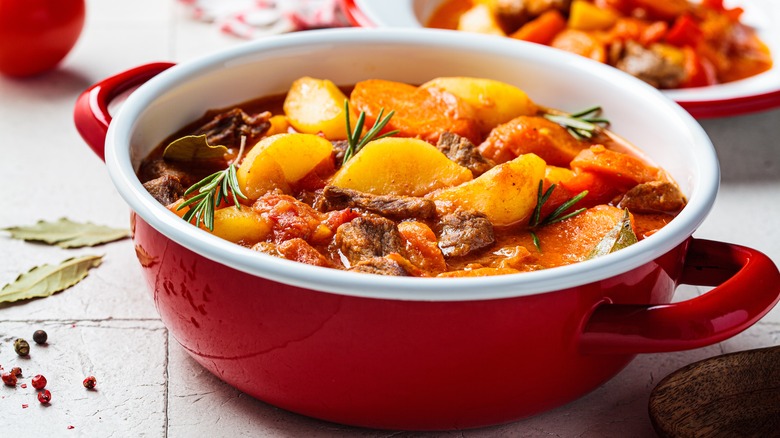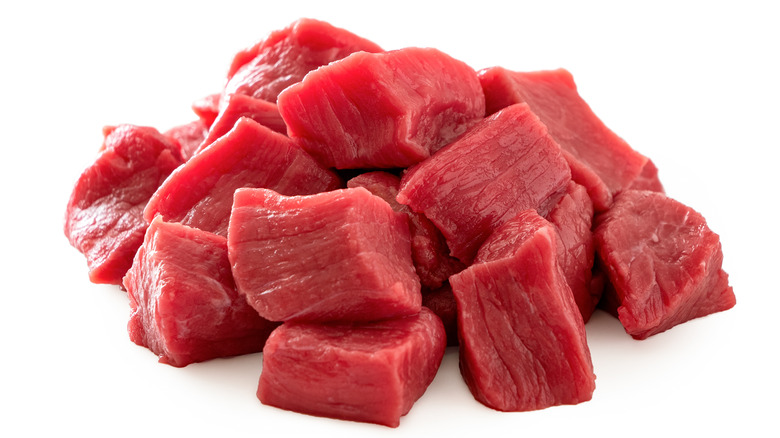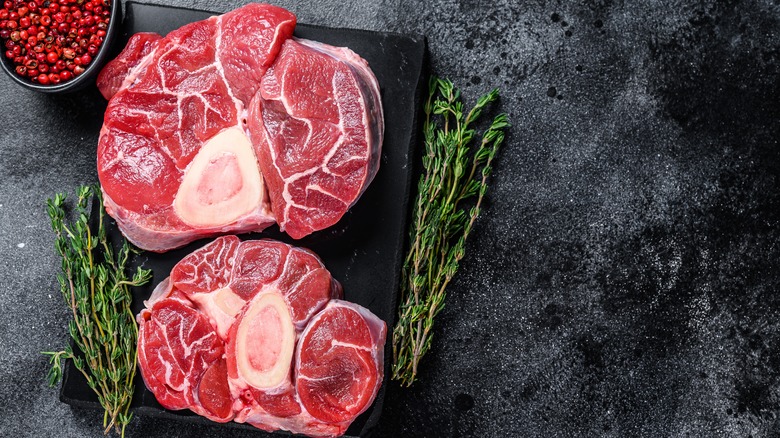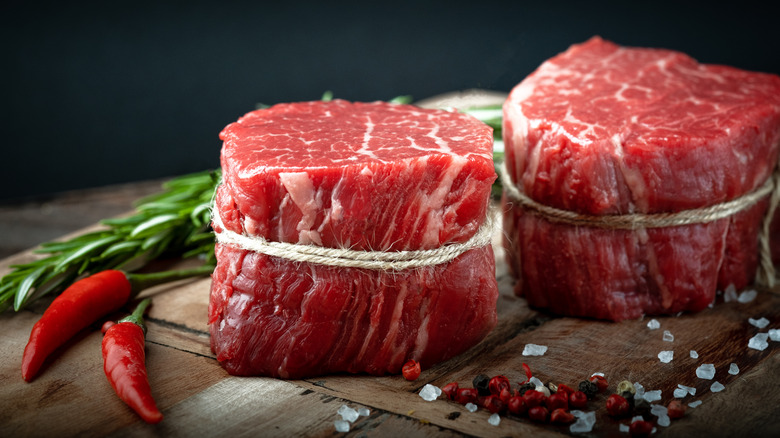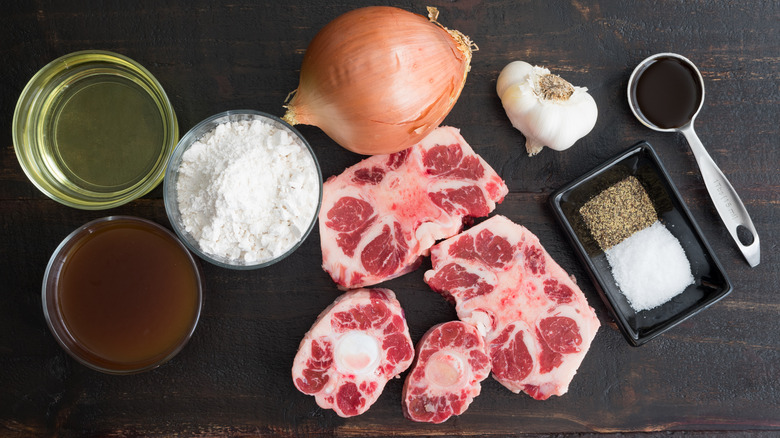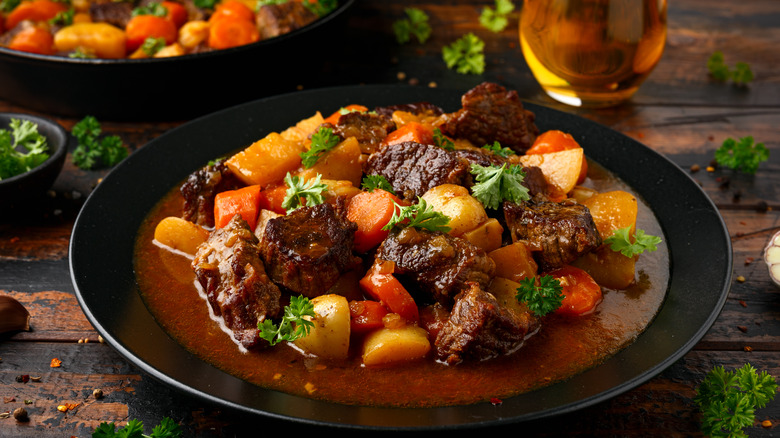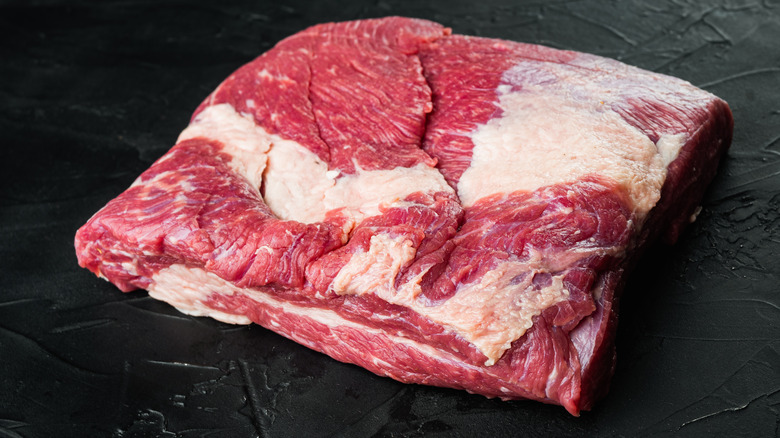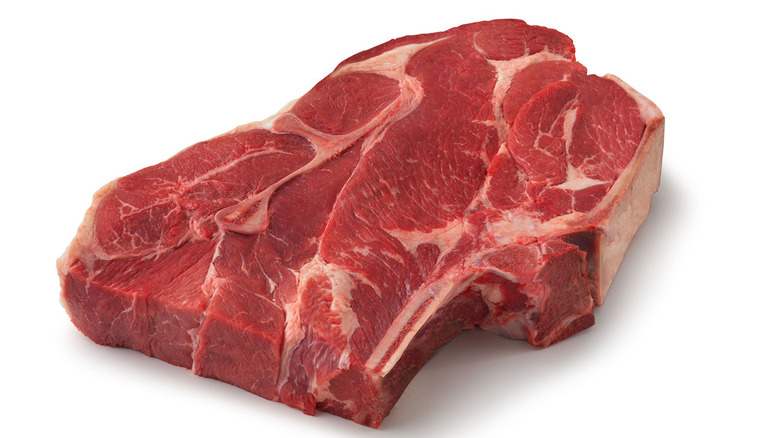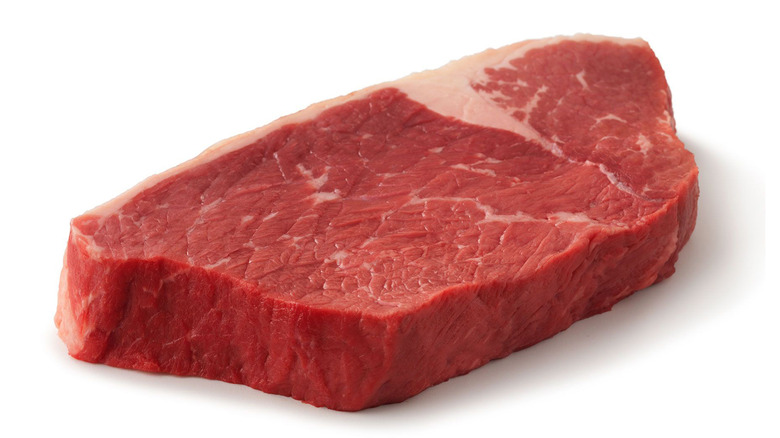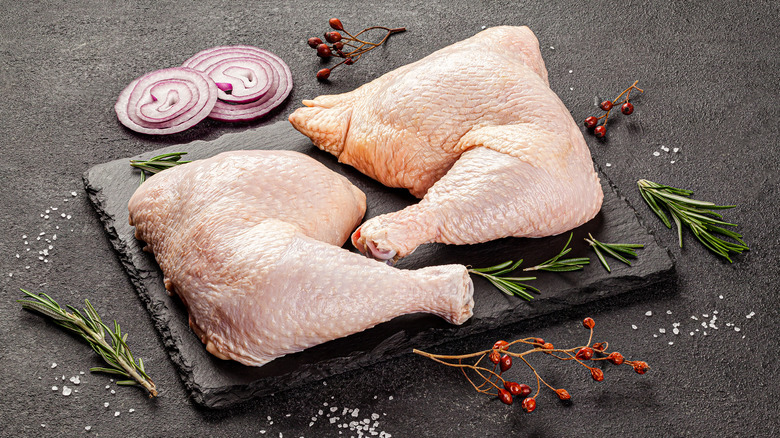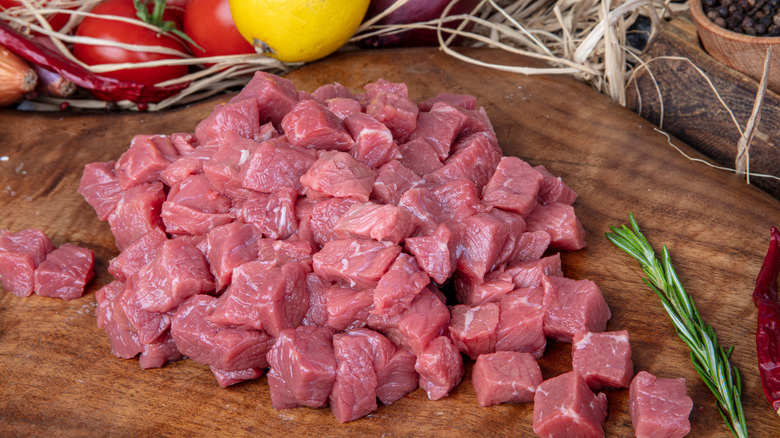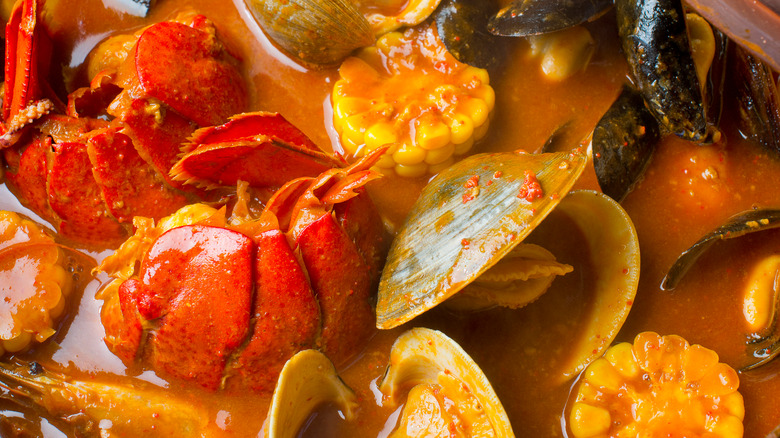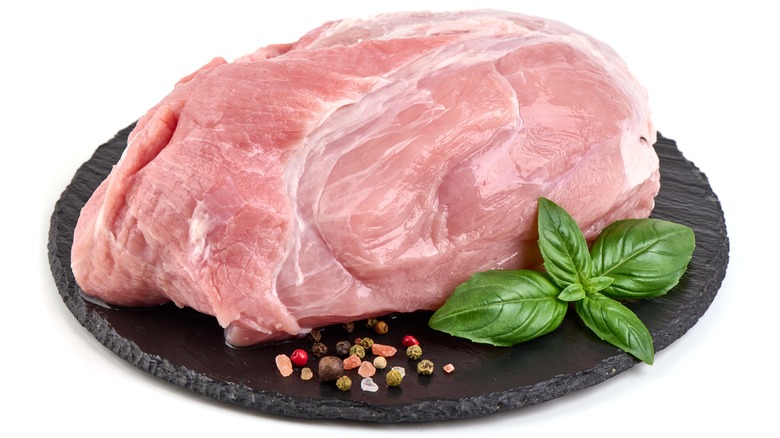Ranking 12 Cuts Of Meat To Use For Stew, Worst To Best
Stew is a welcome sight when you're hungry, especially when it's cold out or you've had a tiring day. While it seems like a dish into which you can throw pretty much anything, it is a lot easier to ruin than you might have realized. One of the classic mistakes that people make in stew is using cuts of meat that do not fare well in a slow-simmered broth.
For our purposes here, "meat" can refer to any animal protein, from beef to chicken to fish, though the American Meat Science Association (AMSA) says that the definition of meat is difficult to pinpoint and can change depending on who you're talking to. Regardless of what you consider to be meat, there's no doubt that the cut of meat you use affects the final dish.
Beef cuts tend to get the most attention in discussions about stew meat, but other proteins like lamb and chicken also have cuts that are better suited to hearty, saucy stew. But, with so many options available, where should you start? Here are some of the common cuts of meat you could use for stew, ranked worst to best, to guide your way.
12. Stewing meat
That's right; stewing meat is quite possibly the worst cut for stew. It's a go-to choice because of the name, but stewing meat is not really a cut. It's actually a grab bag of stuff, often the worst of the animal, says Uno Casa, like offal, fat, leftover bits and pieces, and whatever else wasn't sold. You can find some nicer cuts in there, sure. Yet the overall mix means that, no matter what you do, something won't cook properly, whether something is over or underdone. So, even though this mix is marketed as the one you want for stew, it's really not. Unless you're totally desperate, you should avoid using it.
Even people who like using stewing meat admit that it has its problems. Spend With Pennies lists stewing meat as a good choice for tight budgets but also notes that the variety of cuts in stew meat give the final product a variety of textures. What's more, stewing meat can be very lean, which not all that desirable for stew. You're better off leaving this behind in the grocery store.
11. Cross-cut shank
Cross-cut shank comes from the upper legs of a cow and is sometimes divided into shanks (from the front legs) and hind shanks (via National Cattlemen's Beef Association). The "cross-cut" in the name merely refers to how the final product is a cross-section of the leg. These are lean, tough cuts, according to Essential Chefs, and they are usually left for stew and soup. The shanks are the parts that form the basis for braised dishes like ossobuco, but they don't always do very well in stews despite their tough nature.
Serious Eats lists a number of problems with the cut when it's used for stew. While the meat can be moist in general, some cuts end up drier than others if they have a lot of connective tissue. The cut itself can be deceiving, too, as much of the bulk and weight comes from the bone and not meat. Moreover, the cut is so tough that it often takes quite a while to cook into an edible state. And finally, it's expensive. Redditors posit that shanks are a specialty item for most butchers who aren't slaughtering their own cows, raising the price of this so-so cut.
10. Filet mignon
Why aren't tender cuts best for stew? First, you should know that beef contains muscle tissue, fat, and connective tissue. According to Meathead's Amazing Ribs, intramuscular fat that adds flavor and tenderness to stews. Meanwhile, connective tissue in beef is often hard and cooks into an inedible lump, but there's a soft connective tissue that you want in your meat: collagen. When cooked low and slow like you do for stew, collagen turns into melty, rich gelatin that helps keep the meat moist and counters protein's tendency to toughen up under heat (via Exploratorium). This is why tough cuts of meat tend to be better for stew, as the combined heat and gelatin bath help tenderize the muscle fibers.
Tender cuts like filet mignon are already tender, and so they just don't hold onto fat when cooked in stew, says Southern Living. Nor do they have much collagen, according to Serious Eats, which means that as the beef cooks, the fat will leach out quickly. There won't be enough collagen to keep the meat moist and it will become tough and unpleasant to eat (via Uno Casa). If you have filet mignon at home, don't use it for stew. Instead, Kansas City Steaks suggests grilling, broiling, or pan-searing to get the most out of this expensive cut of meat.
9. Oxtail
Oxtail isn't that bad a cut for stew, although it has some rather prominent disadvantages that will require some extra attention during the cooking process. It does have a decent history in the stew world, however, as oxtail is used for ossobuco, a braised dish. Obviously the cut can be cooked in some sort of liquid and turn out to be delicious.
It's also very fatty and full of collagen, according to both Serious Eats and Uno Casa, so you think it would be wonderful in stew. However, in oxtail's case, there's too much fat and collagen for some people's tastes. The stew can end downright oily, although you can cut off a lot of the visible fat before cooking to counteract this issue.
Then, there are the bones, which can be a bear to deal with. Once you cook down the stew so that the meat is tender, you then have to remove the meat and cut it away from the bone, increasing the amount of time you spend cooking. Plus, the bones provide a lot of the weight that determines the price of the cut — and the cut is pricey — even though you'll likely discard those bones anyway. Finally, Serious Eats notes that oxtail can take a lot longer to cook, often adding at least an hour to the cooking time. Unless you're committed to something like ossobuco, there are better cuts of stew meat ahead.
8. Sirloin tip
Sirloin tip (not top sirloin, which is a different cut entirely) is actually not a bad choice for stew — so long as you choose the right cut. Sirloin tip is typically a lean cut, so you're not going to get a lot of fat-influenced flavor. However, it does boast a good amount of collagen, which means you'll get that velvety gelatin bath that is so coveted in beef stew. The National Cattlemen's Beef Association gives preferred cooking methods for six different sub-parts of the sirloin tip, saying that braising is appropriate for all of them. Yet only one, the sirloin tip steak, is good in stew. It further notes that sirloin tip center steak is more tender than sirloin tip steak.
Why can't you use top sirloin? According to Riemer Family Farm, sirloin tip steak is tougher, less fatty, and more marbled than top sirloin. So while there isn't as much fat overall as in top sirloin, there is a little marbling. This gives you at least a tiny bit of fat to work with. Meanwhile, the toughness of the meat means it has more collagen, which makes it better for stew. If you pay close attention to what you're buying, this could be a decent addition to the stew meat canon.
7. Brisket
Is there anything you can't do with brisket? This formerly cheap cut is a versatile champ — you can roast it, barbecue it, grill it, and yes, stew it. Of course, its popularity has led to it becoming an expensive cut due partly due to demand and also to supply chain issues. It's also a bit pricier than it once was given the current preference for buying larger slabs of brisket instead of the smaller cuts that were more common decades ago (via Carnivore Style).
A brisket actually has two components: the flat and the point. MasterClass says that the point cut is a better choice for stew as it has a little more fat than and is a bit tougher than the flat. You can certainly use the flat cut in stew, but be aware that the lower fat content means less flavor. Serious Eats actually advises against using the flat cut if possible because it may turn too tough to make a good stew. However, the point cut is harder to find. In other words, this sort of stew will take some planning. If you're up to the task and can find the stuff, then go ahead and try a brisket-based stew.
6. Chuck
In the almost-best position are most chuck cuts. Chuck is a large shoulder cut and can be subdivided into several different smaller cuts such as chuck steak and chuck flap (via National Cattlemen's Beef Association). Any of these tough, marbled, moderately fatty, high-collagen cuts will work wonderfully in stews. MasterClass says chuck can be a little pricey, but it's not so pricey that you'd rarely buy it.
Chuck is so good in stews because it's from a part of the cow that gets a lot of activity, making the muscle tough. But because chuck is so large, finding a good piece of chuck meat requires care. Fine Cooking recommends looking for a piece with the fewest number of individual muscles, which means that the meat should be ideally from one chunk of muscle and not multiple muscles connected by intermuscular fat. All of the meat in one muscle will cook at the same time, but different muscles may cook faster or slower than others. Looking for the fewest muscles makes it more likely that the cut you get will cook evenly.
5. Chuck roast and round roast
Chuck roast is one particular sub-cut of chuck and is a winning cut for stew. According to Uno Casa, the cut has an excellent amount of collagen. But chuck roast shares the spotlight with round roast, a cut from the back end of the cow, behind the sirloin and above the rear shank. Round roasts are lean and are available in top and bottom round options. MasterClass says the bottom round is tougher than the top round, making bottom round perfect for stewing.
There's one more reason round roasts are among the best cuts for beef stew: price. The Kansas Beef Council lists both top and bottom round as two of the most affordable cuts of meat for cheap meals. And given how beef prices have been increasing over the past few months — about 15% over the past year, according to Vox — affordability is key. So, if you want a relatively inexpensive meal sometime, get some bottom round roast and make a rich, soothing beef stew.
4. Chicken and turkey
Beef isn't the only meat that you can use for stew. Chicken is one of the easier meats to use for a comforting dish, namely because there aren't that many cuts to begin with, and they are incredibly easy to find. Stewing chicken is straightforward; you want pieces with lots of collagen and some fat, which pretty much limits you to using thighs and drumsticks. Fine Cooking recommends removing the skin and using bone-in thighs because the skin develops a "soggy" texture, but the San Antonio Express-News suggests leaving the skin in the stew as it cooks, given that it's a major source of collagen. Either way, you probably don't want to use chicken breasts for stew, as these lean cuts will easily dry out and become the exact opposite of comfort food.
We can't forget turkey, either. Leftover turkey after Thanksgiving is ubiquitous and turns out to be a pretty good stew ingredient, even if you only have breast meat left. If you have no leftover cooked turkey but want to try a turkey stew, try this Kentucky burgoo recipe from the Kentucky Derby website. There, a mix of beef, pork, turkey breast, and vegetables is simmered for a couple of hours, producing a tender stew that pairs nicely with wine.
3. Lamb and goat
Several cuts of lamb do well in stew, although the time each takes to cook will vary greatly. This means you likely won't want to use different cuts at the same time. Be aware that lamb cuts are known by different names in different countries. Clove Garden says the U.S. has two systems for naming cuts. Canada uses the U.S. system, while the U.K. appears to be adopting an Australian framework. We hope there won't be a quiz later.
Hugh Phillips Gower Butcher lists six cuts that produce a flavorful stew with tender meat: scrag end (the top of the neck closest to the head), neck (the shoulder in the U.S.), neck fillet, shoulder or leg (foreshank or leg in the U.S.), chump (the rear portion of the loin), and breast. Jamie Oliver recommends using the legs, shanks, and neck for best results.
Goat meat also lends itself well to stewing if you keep it moist with a marinade, says MasterClass. The meat tends to be very lean and can get tough. To avoid that last issue, you have to cook it using very low heat for a very long time, such as in a slow cooker (via Hay Manager). As for which cuts are best for stew, the Gourmet Goat Lady recommends the foreshank, hindshank, shoulder, and leg. If you don't mind the extra effort, though, it can be a interesting and flavorful addition to your stew repertoire.
2. Fish and shellfish
Fish and shellfish share a common problem in stew: they can become mushy and very definitely not tender, if you're not careful. The problem, according to Australia's SBS Food, is that "delicate" fish and flaky fish both fall apart when cooked for a long time in stew liquid, resulting in a disappointing mouthfeel. If you're going to use this variety of protein, you need some way to protect them, or you need to find a fish with firm flesh that will last in a long, slow simmering broth. Cooking shellfish in the shell is one way to protect that type of meat when subject it to the heat of a stew, as in the classic Italian dish, cioppino.
Fish and shellfish do contain collagen, but the Beautyholic says that the collagen-rich portions typically aren't eaten. However, you can take fish bones and heads and make a fish bone broth while you use the meat of the fish for a separate stew. Great types of fish for stew, in addition to shellfish left in the shell, include whiting, dory, and ling. With a bit of thought and effort, a seafood-based stew can be uniquely rich and satisfying.
1. Pork
A lot of pork meat you can find in the store is too lean for stew, per the San Antonio Express-News, but there is a cut that will work very well indeed: bone-in shoulder roast. Like good beef cuts, this pork cut has a lot of collagen and some fat, but unlike beef cuts, you actually want the bone in the stew as it cooks, as it will add great flavor. With the right cut and some time, pork stew hits just about all the right notes, with excellent texture and a taste that will have you asking for seconds.
If you can't get a bone-in shoulder roast, consider two substitutions. One is to look for Boston butt pork roast, which comes from a spot adjacent to the shoulder roast on a pig. This cut has more fat and requires more cooking time, but that extra fat also means extra flavor. The other option is to acquire pork tenderloin, which does not have a lot of fat, and as you can guess from the name, is very tender. That said, it will cook quickly if you want to have stew ready in a shorter amount of time. And if you don't want to spend a lot of time looking for different pork cuts, you can always grab some kielbasa, which is often made of pork. With so many options and such great potential for flavor, pork is primed to be the star of a beloved stew.
